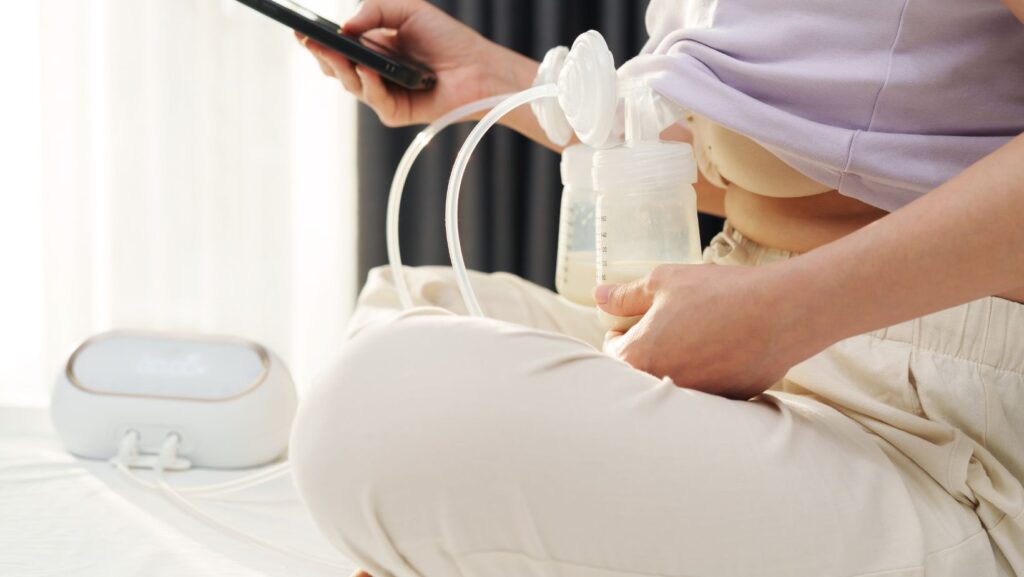Breast pumping can be a valuable part of your feeding journey—whether you’re building a freezer stash, returning to work, or simply adding flexibility to your day. But if you’re new to pumping, you may wonder, “what should pumping feel like?”
Understanding what’s normal and what’s not can help you pump more comfortably, protect your milk supply, and prevent unnecessary pain. The right breast pump, proper technique, and correct equipment fit can make all the difference.
Understanding the Basics: Pumping Shouldn’t Hurt
Pumping should be a comfortable experience—not something you dread. While you may feel a gentle pulling or tugging sensation, sharp or prolonged pain is a clear signal that something isn’t right.
Several factors can cause discomfort, such as:
- Incorrect flange size – Too big or too small can create unnecessary friction.
- High suction levels – More suction doesn’t mean more milk; it often just means more soreness.
- Clogged ducts – Blockages can make pumping uncomfortable and even lead to mastitis if not addressed.
It’s a common myth that “a little pain means you’re getting more milk.” In reality, pain can cause your body to tense up, which may slow milk flow and make sessions less productive. The true goal is comfortable, efficient milk removal.
Using a high-quality breast pump, like those in the Momcozy Electric Breast Pump collection, can make all the difference. These pumps are designed to mimic a baby’s natural suckling rhythm, helping you express milk effectively while keeping you at ease.
What a Normal Pumping Sensation Feels Like
When pumping is going well, you’ll likely notice:
- A gentle tugging or pulling on your nipple
- A steady rhythm that mimics a baby’s sucking
- Mild tingling or warmth as milk begins to flow (the letdown reflex)
- No pinching, burning, or sharp pain
At first, the sensation may feel unusual simply because your body isn’t used to the pump. Over a few sessions, this typically becomes routine, and many moms find it soothing.
Gentle Tugging vs. Pinching or Sharp Pain
The difference between “normal” and “not normal” often comes down to comfort vs. pain.
- Gentle tugging means the pump is creating the right vacuum to remove milk without damaging your nipple or areola.
- Pinching, rubbing, or sharp pain means something is off—possibly the flange is too small, too large, or the suction is set too high.
- Nipple blanching (turning white) can indicate poor circulation due to flange fit or excessive suction.
If you experience pain, don’t try to “push through it.” Stop, check your setup, and make adjustments.
Common Causes of Discomfort While Pumping
Even experienced pumpers can run into discomfort. The most common reasons include:
- Wrong Flange Size – A flange that’s too small compresses the nipple; too large can pull in too much areola. Both can cause pain and reduced output.
- High Suction Settings – Stronger suction doesn’t always mean more milk—it can actually slow milk flow if it causes tension.
- Dry Nipples – Lack of lubrication can cause friction. A few drops of expressed milk or a safe nipple cream can help.
- Poor Pump Alignment – Even a slight angle can lead to rubbing and soreness.
- Extended Pumping Sessions – Pumping for too long can cause swelling and sensitivity.
- Clogged Ducts or Mastitis – These medical issues can make any suction painful, requiring gentle treatment before resuming regular pumping.
How Flange Fit and Suction Settings Affect Sensation
The flange is the part of the breast pump that fits over your nipple and areola. If it’s the wrong size, pumping can feel uncomfortable or even cause damage.
Signs of a good flange fit:
- Your nipple moves freely in the tunnel without rubbing
- Only a small amount of areola is drawn into the tunnel
- No pain or pinching sensation
- No excessive redness after pumping
Suction settings should be adjusted for comfort. Start low and gradually increase until milk flows steadily but without discomfort. Remember—your goal is effective milk removal, not maximum suction power.

With an adjustable pump like those from Momcozy, you can fine-tune both suction strength and rhythm to match your body’s needs.
What to Do If Pumping Feels Uncomfortable
If you notice pain or discomfort:
- Stop and Check – Pause your session and reassess flange size, suction setting, and alignment.
- Use Lubrication – A thin layer of breast milk or nipple balm can reduce friction.
- Apply Warm Compresses – This can help relax ducts and improve letdown.
- Massage Before Pumping – Gentle breast massage before and during pumping can make milk flow easier.
- Shorten Sessions – Pumping in shorter bursts more frequently may be gentler.
- Replace Worn Parts – Old valves, tubing, or flanges can impact performance and comfort.
When to Talk to a Lactation Consultant
If discomfort persists despite adjustments, it’s a good idea to contact a lactation consultant (IBCLC). They can:
- Assess your pump fit in person or virtually
- Teach you techniques for more comfortable pumping
- Help troubleshoot issues like low supply, clogged ducts, or nipple damage
Sometimes, discomfort may be a sign of an underlying breastfeeding issue, and an IBCLC can help address both pumping and nursing challenges.
Listening to Your Body and Finding What Works for You
Every mom’s pumping experience is unique. What feels comfortable for one person may not work for another. That’s why it’s important to:
- Experiment with different suction levels and flange sizes
- Adjust pumping schedules to match your supply and comfort
- Monitor how your breasts feel before, during, and after pumping
- Take breaks and care for your breast health with gentle massages and hydration
Remember: pumping is a skill, and it often takes time to find your rhythm. With the right approach, it should feel productive and comfortable—not something you dread.
Conclusion
Pumping should never be painful. A gentle tugging sensation, steady milk flow, and no lasting discomfort are signs you’re doing it right. Pain, pinching, or excessive redness are indicators that something—flange size, suction setting, or technique—needs adjusting.
By choosing a reliable and comfortable pump, such as the Momcozy electric breast pumps, and staying mindful of your body’s feedback, you can make pumping a smooth and positive part of your feeding journey.
With patience, the right tools, and good technique, pumping can become a comfortable routine that supports your breastfeeding goals without causing unnecessary stress or pain.


